FasTracks will transform Denver Union Station (DUS) into a multi-model transportation hub. This $480 million+ DUS project is part of a larger, $6.1 billion ($7.1 billion after most recent cost estimate) transportation project called FasTracks. FasTracks will construct four new commuter rail lines (2-EMU; 2-DMU), one new Light Rail Line (LRT), and extend three existing LRT lines. It will also include a 38-mile Bus Rapid Transit (BRT) line. The BRT line will have limited access ROW down a medium of a highway and operate just as a rail line. All of this is to be completed & operational by 2017 - making it the nations most ambitious transportation project in recent memory.
But of course, the center piece that everything feeds into, is Denver Union Station in LoDo (Lower Downtown). DUS will consist of four main parts: Historical Denver Union Station, Commuter Rail Terminal, Regional Bus Terminal and Light Rail Terminal.
-The historical DUS building will serve as the gateway between the terminals and downtown. As well as serve as the main waiting area for longer duration transfer waits. The station will serve AmTrak, SkiTrain, Commercial buses and future inter-city rail in addition to the commuter rail, light rail and regional buses - so some transfer layovers will be longer than a few minutes.
-The Commuter Rail Terminal (CRT) will consist of 8-tracks, directly behind the historic Union Station. It will be accessible directly from Union Station at-grade level, as well as have individual platform access from the subterranean Regional Bus terminal (RBT), and access from an elevated pedestrian bridge which crosses the tracks. It will be served by a below-grade 18th Street Free Circulator Bus stop, as well as an at-grade 16th Street Free Mall Ride Bus stop. In other words, this terminal will have seamless and integrated access from in front, behind, below, above, from the left and from the right of it.
-The Regional Bus Terminal (RBT) will be subterranean, below 17th Street Transportation plaza. This terminal will stretch from Union Station and the CRT, down to the Light Rail Terminal (LRT). There will be 22-bus bays; 16-regional bus bays, 4-Circulator bus bays, 2-commercial bus bays (actually a transfer bus which will shuttle passengers to and from commercial bus stations such as Greyhound). Down the medium of this will be an enclosed pedestrian walkway, with moving sidewalks to assist in transfers.
-At the far end of the RBT is the Light Rail Terminal (LRT). The LRT will have a 2-track covered platform with direct, covered access to the below-grade bus terminal and pedestrian tunnel to Union Station. There will also be room for a future third rail platform, which would be used for a separately proposed inter-city, Front Range Commuter High-Speed Rail Service from Fort Collins, CO to Albuquerque, NM (possibly El Paso/Juarez, Chihuahua, Mexico) and a separate Denver west to Ski resorts branch.
Denver Union Station:






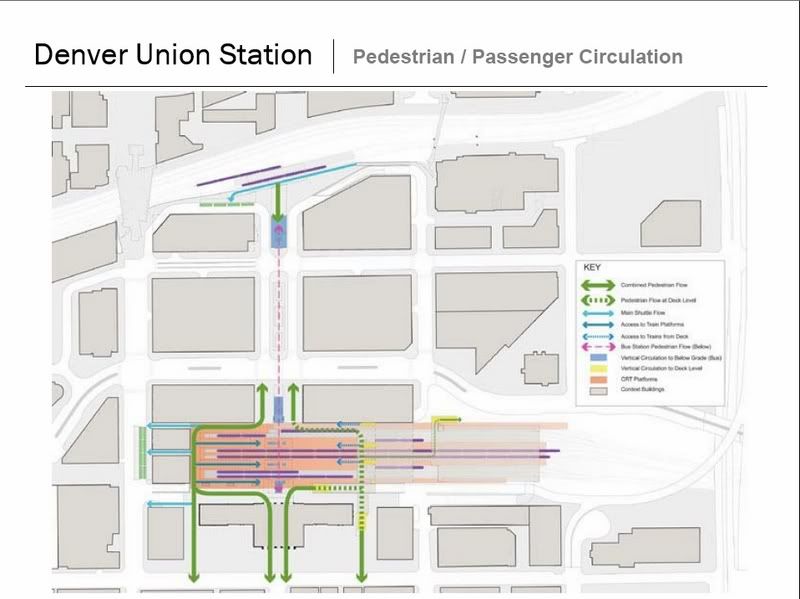
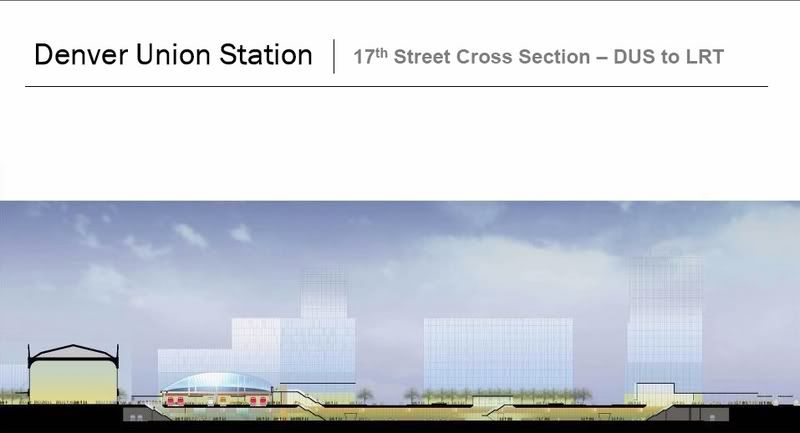
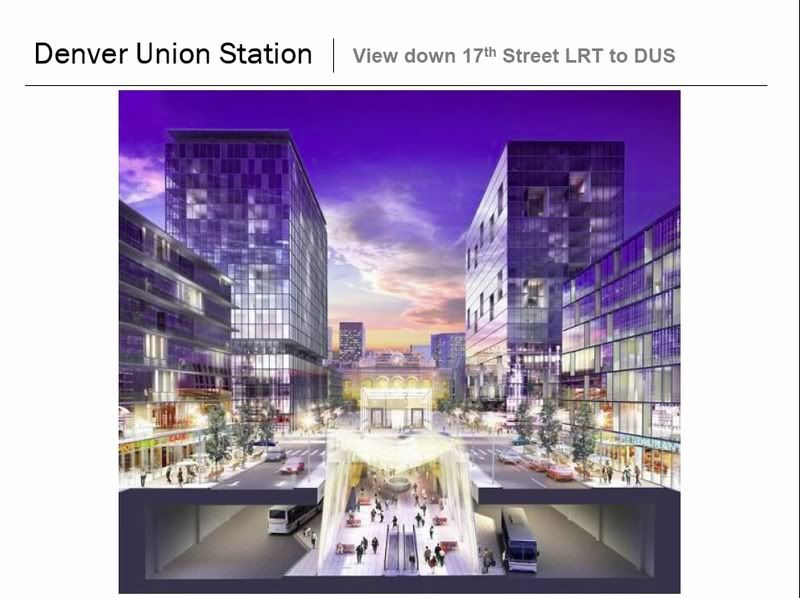
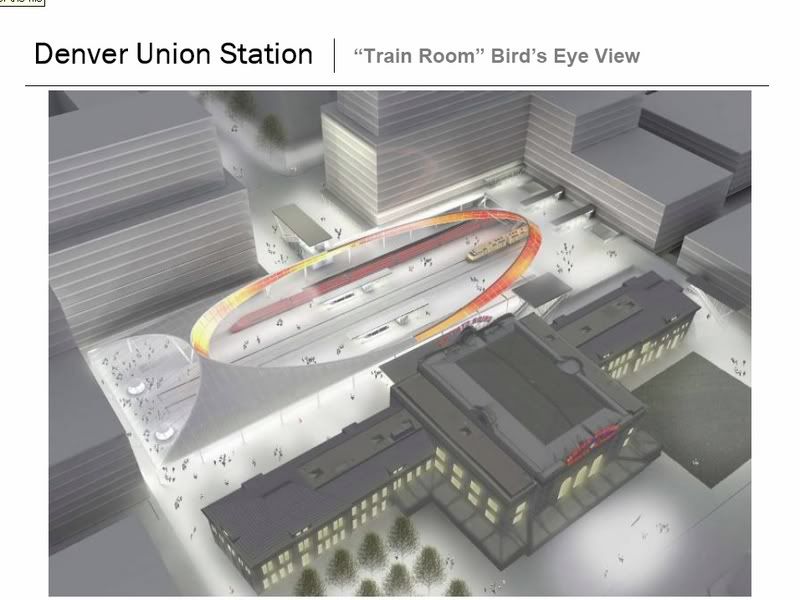

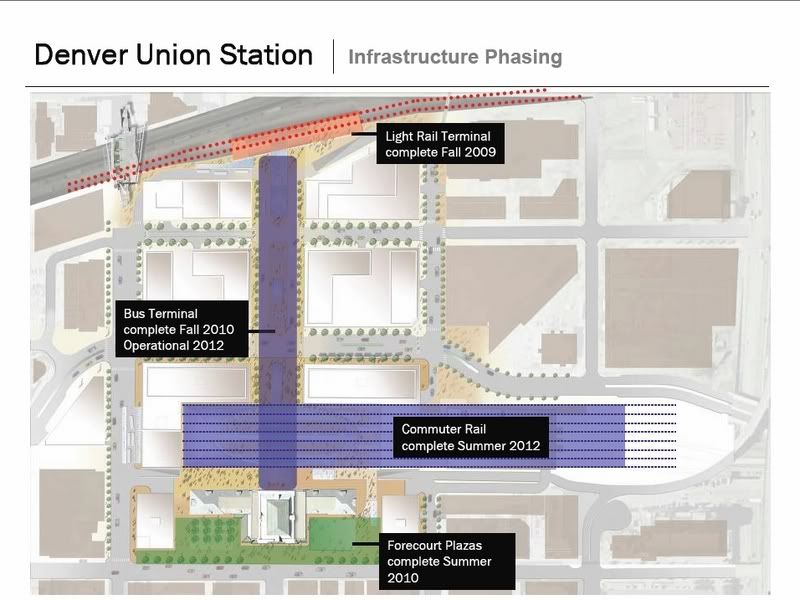
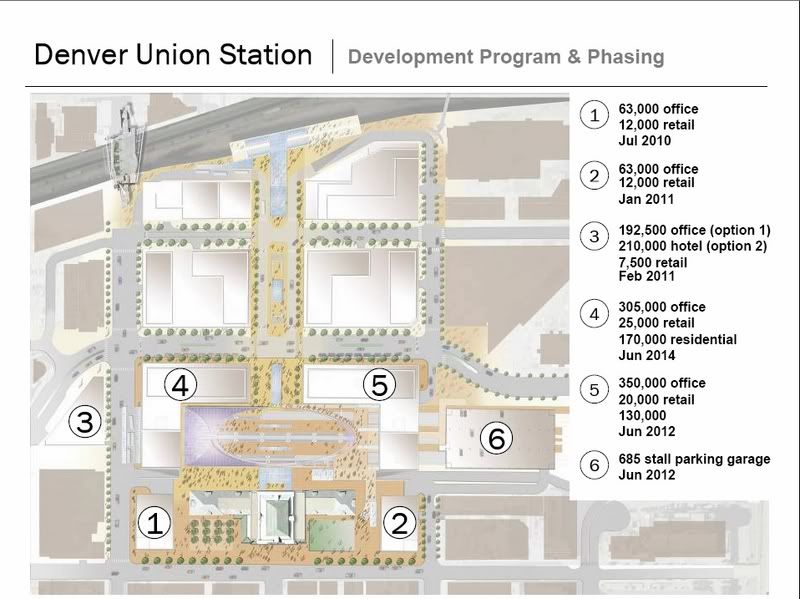 Full Update Report: Click This Link
FasTracks: The Whole System
Full Update Report: Click This Link
FasTracks: The Whole System
FasTracks is RTD's 12-year comprehensive plan to build and operate high-speed rail lines and expand and improve bus service and park-n-Rides throughout the region. FasTracks includes:
* 119 miles of new light rail and commuter rail
* 18 miles of bus rapid transit service
* 21,000 new parking spaces at rail and bus stations
* Expanded bus service in all areas
FasTracks provides many ways to ride a bus or train.
* Drive to a park-n-Ride and get on a bus or train
* Take a bus to a rail station
* Walk to a bus or rail station
* Ride your bike to transit stations and store your bike in lockers and racks or take it with you on buses and trains


 East Corridor
East Corridor
Vehicle Type: Commuter Rail - Electric Multiple Units (EMU)
Length (miles): 23.6
Stations: 5
Parking: 2,848 (existing), 400(new)
Capital Cost: $1.14B*
2030 Ridership: 37,500
Proposed Frequency of Service (Rail): 15 min (peak)/15 min (off-peak)

The East Corridor is a 23.6-mile commuter rail transit corridor between Denver Union Station and Denver International Airport (DIA). The East Corridor serves as a connection between these two important areas and travels through the adjacent employment, neighborhoods, and new development areas.
Final Design is scheduled to begin in 2008, and construction is scheduled to begin 2011 with opening day on the East Corridor scheduled for 2015.
--------------------------------------------------------------------------
North Metro Corridor
Vehicle Type: Commuter Rail - Diesel Multiple Units (DMU)
Length (miles): 18
Stations: 8
Parking: 2,992 (existing/planned), 3,767 (new)
Capital Cost: $637.2M*
2030 Weekday Ridership: 24,100
Proposed Frequency of Service (Rail): 15 min (peak)/30 min (off-peak)

The North Metro Corridor is a proposed 18-mile rail transit corridor
between Denver Union Station and 162nd Avenue, passing through Denver,Commerce City, Thornton, Northglenn and unincorporated Adams County. Project will be finished in 2015.
--------------------------------------------------------------------------
Northwest Rail Corridor
Vehicle Type: Commuter Rail - Diesel Multiple Units (DMU)
Length (miles): 41
Stations: 7 (rail)
Parking: 3,975 (existing), 4,393 (new)***
Capital Cost: $684.4M*
2030 Weekday Ridership: 17,400
Proposed Frequency of Service: 15 min (peak), 30 min (off-peak)

The Northwest Rail project is a proposed 41-mile high-capacity, fixed-guideway transit corridor from Denver Union Station to Longmont, passing through North Denver, Adams County, Westminster, Broomfield, Louisville, and Boulder. Project to be finished in 2014.
-------------------------------------------------------------------------
US 36 BRT Corridor
Vehicle Type: Bus Rapid Transit (BRT)
Length (miles): 18
Stations: 6
Parking: 3,975 (existing), 4,393 (new)***
Capital Cost: $235.6M*
2030 Weekday Ridership: 14,600
Proposed Frequency of Service: 2 min (peak), 4 min (off-peak)

The US 36 Corridor is an 18-mile Bus Rapid Transit Corridor between Downtown Denver and Boulder in the median of US 36. The FasTracks program includes funding for slip ramps and access improvements to park-n-Rides along the corridor. In addition, FasTracks funds centerline BRT stations, platforms and a proportional share of HOV lanes ($66 million) as part of future CDOT improvements to US 36.
The US 36 Corridor began as a two-pronged corridor; the BRT and the Commuter rail line from Denver through Boulder to Longmont. The rail and BRT corridors split into two separate projects in 2006 and are now known as the Northwest Rail Corridor and US 36 BRT Corridor.
The Environmental Impact Statement for US 36 began in 2003 and is planned to be complete in 2007. Phase 1 improvements, which include the slip ramps and some park-n-Ride improvements, will open in early 2009. Phase 2 Final Design is scheduled to begin in 2008, be completed in 2011 and the line is scheduled to open in 2015.

-----------------------------------------------------------------------------------------
Gold Line Corridor
Vehicle Type: Commuter Rail - Electric Multiple Units (EMU)
Length (miles): 11.2
Stations: 7
Parking: 711 (existing), 2,050 (new)
Capital Cost: $552.5M*
2030 Weekday Ridership: 18,000 - 20,000
Proposed Frequency of Service (Rail): 7.5 min (peak)/15 min (off-peak)

The Gold Line is a proposed 11.2-mile rail transit corridor from Denver Union Station to the vicinity of Ward Road, passing through northwest Denver, unincorporated Adams County, Arvada and Wheat Ridge. Project will be completed in 2015.
--------------------------------------------------------------------------
West Corridor
Vehicle Type: Light Rail
Length (miles): 12.1
Stations: 12
Parking: 646 (existing), 5,054 (new)
Capital Cost: $635M*
2030 Weekday Ridership: 31,200 - 36,500
Proposed Frequency of Service (Rail):
5 min (peak)/15 min (off-peak) Denver to Federal Center
15 min (peak and off-peak) Federal Center to Jefferson County

The West Corridor is a 12.1-mile light rail transit corridor between the Auraria Campus in downtown Denver and the Jefferson County Government Center in Golden, serving Denver, Lakewood, the Denver Federal Center, Golden and Jeffco.
The West Corridor completed the Environmental Impact Statement in 2003 and began Final Design in November 2005. The Final Design was completed in early 2008 and utility realignments were begun. In the summer of 2009, full construction phase was begun. It will be the first corridor to be completed in the FasTracks program, opening in early 2013.
-------------------------------------------------------------------------
Southwest Corridor
Vehicle Type: Light Rail
Length (miles): 8.7 (existing)/2.5 (new)
Stations: 5 (existing)/2 (new)
Parking: 2,597 (existing), 1,440 (new)
Capital Cost: $216.9M*
2030 Weekday Ridership: 21,600 - 24,000
Proposed Frequency of Service (Rail): 6 min (peak)/7.5 min (off-peak)

The Southwest Corridor light rail line opened in July 2000 as an 8.7-mile extension from I-25/Broadway to Mineral Avenue in Littleton. The Southwest Corridor has five stations with nearly 2,600 parking spaces.
A number of enhancements are proposed as part of FasTracks to make the Southwest line even more successful than it is today. Enhancements include improving existing stations so that they can accommodate four-car trains, adding a total of 440 parking spaces at the Englewood Station, and extending the line south from Mineral Avenue to Lucent Boulevard in Highlands Ranch with a new station at C-470/Lucent Boulevard with 1,000 new parking spaces. Finally, a new station will be added in Englewood at Bates Avenue when a new planned development is constructed.
--------------------------------------------------------------------------
Southeast Corridor
Vehicle Type: Light Rail
Length (miles): 19.1 (existing)/2.3 (new)
Stations: 13 (existing)/3 (new)
Parking: 6,962 (existing), 2,520 (new)
Capital Cost: $208.1M*
2030 Weekday Ridership: 51,100 - 59,800
Proposed Frequency of Service (Rail): 4 min (peak)/6 min (off-peak)

The Southeast Corridor is a 19.1-mile light rail line from I-25/ Broadway to Lincoln Avenue in Douglas County with an additional connection from I-25 to Parker Road along I-225. This portion of the Southeast Corridor began passenger service in November 2006.
FasTracks enhancements include a 2.3 mile light rail extension to Lone Tree, increasing total corridor parking by 2,520 spaces, and improving existing stations so that they can accommodate four-car trains.
-------------------------------------------------------------------------
I-225 Corridor
Vehicle Type: Light Rail
Length (miles): 10.5
Stations: 7
Parking: 1,225 (existing), 1,800 (new)
Capital Cost: $619.6M*
2030 Weekday Ridership: 34,200
Proposed Frequency of Service (Rail): 7.5 min (peak)/10 min (off-peak)

The I-225 Corridor project is a 10.5-mile proposed light rail line that connects the Southeast Corridor light rail station at Parker Road and I-225 and the East Corridor at Smith Road and Peoria. The alignment follows I-225 in the median between the Parker Road and the Aurora City Center area where it leaves the median and travels through the Aurora City Center area. The alignment returns to the median of I-225 and continues to Colfax Avenue where it turns west to serve the Fitzsimons redevelopment area. This proposed light rail mode line continues north along Peoria Street to Smith Road, where a cross-platform transfer to the East Corridor rail line to the Denver International Airport (DIA-eastbound) or downtown (DUS-westbound), is provided.
The I-225 Corridor will serve Aurora (300,000 people), in addition to providing a key regional rail linkage between the East and Southeast rail lines and connecting the regions 2nd largest job center (Denver tech Center) to the regions Airport (DIA).
-------------------------------------------------------------------------
Central Corridor
Vehicle Type: Light Rail
Length (miles): 7.1 (existing)/0.8 (new)
Stations: 18 (existing)/2 (new)
Parking: 1,685 (existing)
Capital Cost: $115M*
2030 Weekday Ridership: 5,800
Proposed Frequency of Service (Rail): 15 min

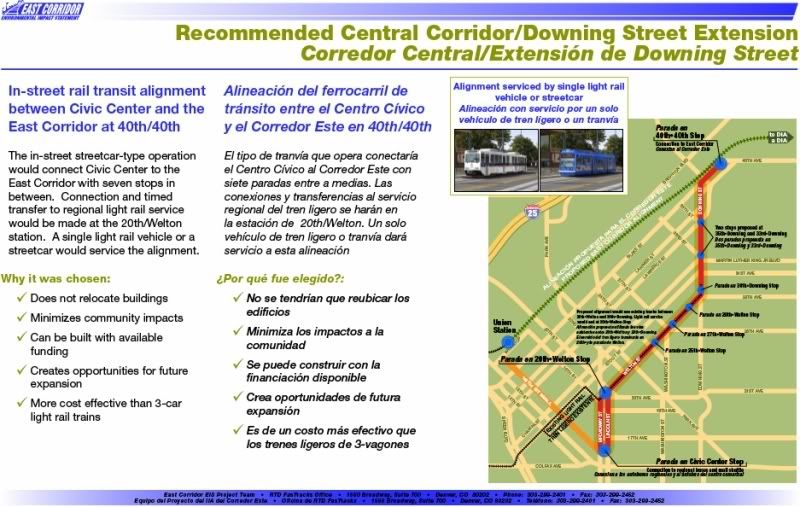
The 5.3 mile Central Corridor light rail line originally opened in 1994 and is Denver's first light rail line running from I-25/Broadway, through downtown Denver, and along Welton Street to 30th/Downing. The light rail extension as part of FasTracks takes the line north on Downing Street less than a mile to the 40th/40th Station, where it will share a transfer station with the East Corridor. This line is being studied for a potential conversion into a streetcar style single light rail vehicle line--as it runs on city core streets.
-------------------------------------------------------------------------------
Schedule:
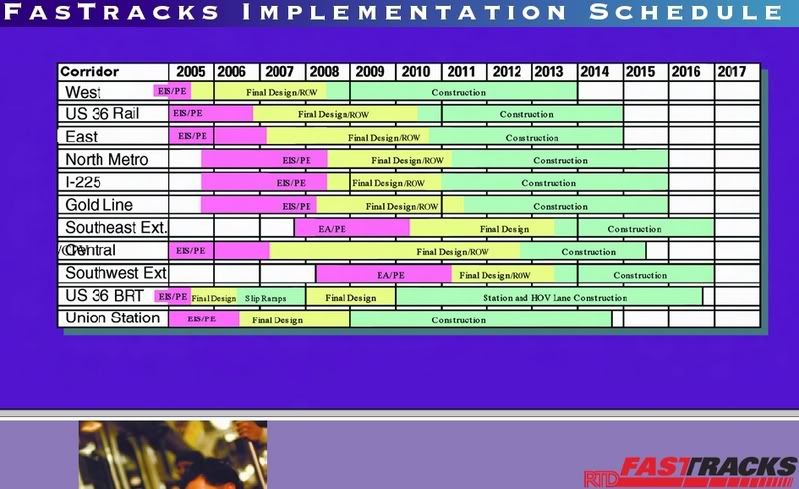 RTD FasTracks FAQ's
RTD Transit Tech PDF
RTD FasTracks Factbook PDF
RTD FasTracks FAQ's
RTD Transit Tech PDF
RTD FasTracks Factbook PDF



